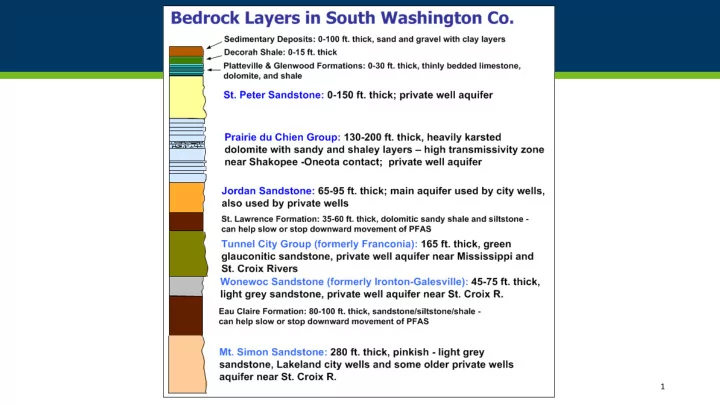

1
Bedrock Geology of South Washington Co. B I-94 B’ A A’ Washington County Geologic Atlas, Plate 2 (Steenberg & Retzler, 2016) 2
Groundwater Flow in South Washington County • A groundwater divide extends from north to south beneath the county • West of the divide - flows to Mississippi River • East of the divide - flows to St. Croix River • Flow “fans out” near confluence of rivers • Buried bedrock valleys exert significant control over local flow directions 3
PFAS in groundwater – Washington County, MN • PFAAs highly soluble, mobile, persistent = very large plumes • Much larger than predicted by models • Co-mingled plumes • PFBA most widespread • Extremely soluble and mobile = groundwater tracer • Distal plume difficult to distinguish from “ambient” levels • Distribution controlled by: • Bedrock features (buried valleys and faults ) • Groundwater divide (Mississippi R. and St. Croix R. ) • Groundwater - surface water interactions • PFAS chemical properties (partitioning) • Source area PFAS “signature” • Groundwater pumping 4
PFOS & PFOA are the PFAS of Main Concern • Bioaccumulate • Very low Health Based Values • PFOS: 0.027 ppb • PFOA: 0.035 ppb • PFHxS: 0.027 ppb (surrogate), but not widespread • Driving most of the current investigations and well advisories • Relative amounts vary by disposal site • High PFOS levels in 3M-Oakdale • Modest PFOS levels in 3M-Woodbury • Low PFOS levels in Wash. Co. landfill 5
Aquifer use varies across the county • Groundwater PFAS data is primarily from private wells • Large areas with no private wells (city water) • Large areas where most wells access the same aquifer (limiting our ability to map vertical distribution of PFAS) • Older wells tend to be in shallower aquifers (St. Peter and Prairie du Chien); well code requirements mean most newer wells are in the Jordan or deeper aquifers. • Most private wells are completed in the Prairie du Chien (OPDC) or Jordan (CJDN), which are hydrologically connected • Where wells in both aquifers are present, it appears the extent of the PFAS plumes are similar in both, but • In some areas OPDC has slightly higher concentrations 6
PFOS by “Aquifer” 7
PFOA by “Aquifer” 8
Location of wells sampled for PFAS and private well advisories 9
Recommend
More recommend